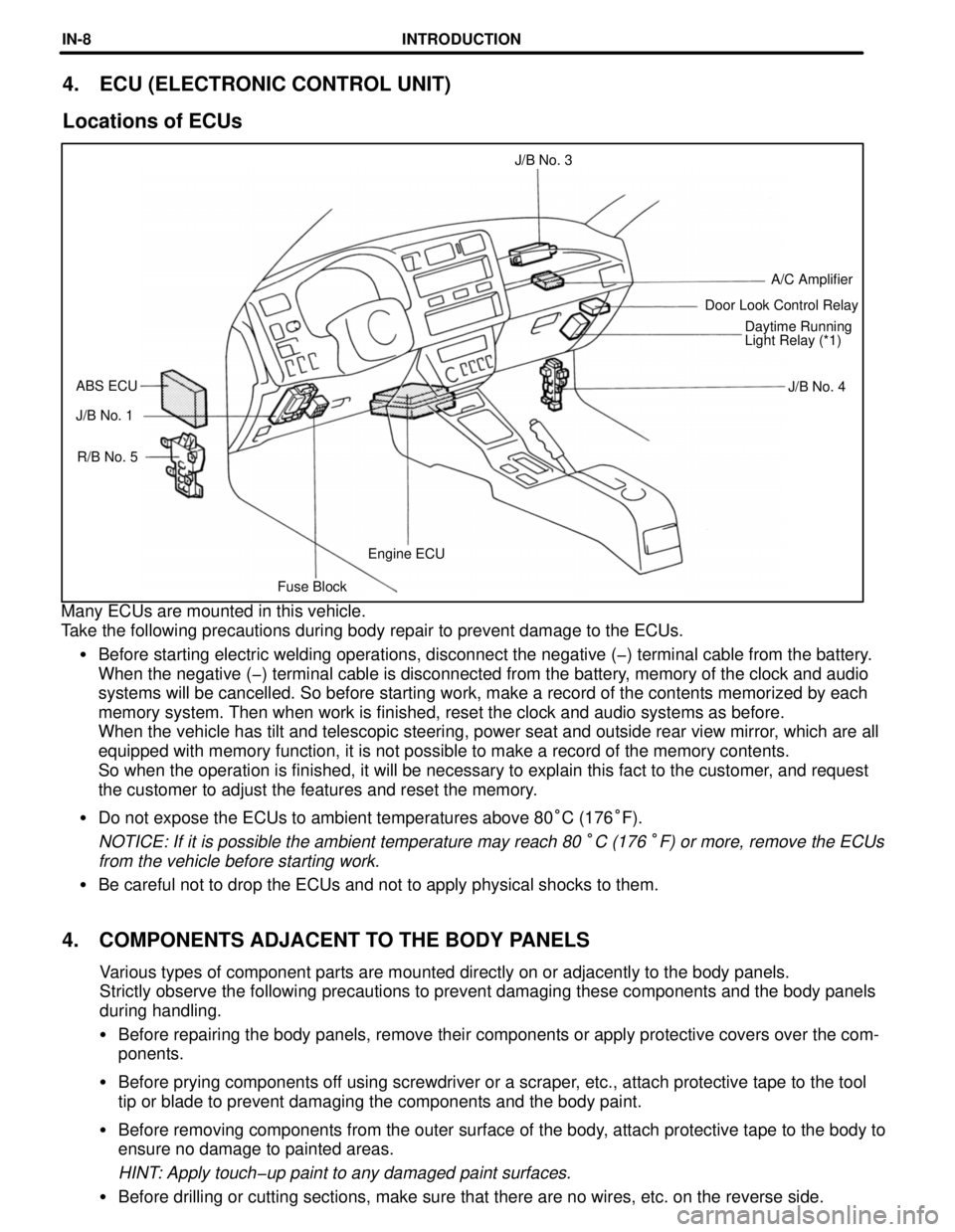Page 17 of 1354

Q08774
Q08768
D01757
Q08769
C
D
NutAB C
D
A
B
B
B
Nut
Q08770
− AUTOMATIC TRANSAXLE (A241E)AUTOMATIC TRANSAXLE UNIT
AX−17
1996 RAV4 (RM447U)
15. DISCONNECT FOLLOWING CONNECTORS
�Shift solenoid valve SL connector
�Park/neutral position switch connector
�Vehicle speed sensor connector
16. DISCONNECT 2 OIL COOLER HOSES
Loosen the 2 clips and disconnect the 2 oil cooler hoses.
17. REMOVE 2 POWER STEERING GEAR MOUNTING
BOLTS AND NUTS
Torque: 113 N·m (1,150 kgf·cm, 83 ft·lbf)
NOTICE:
Support the power steering gear housing securely.
18. REMOVE FRONT SUSPENSION CROSSMEMBER AS-
SEMBLY WITH STABILIZER BAR
Remove the 10 bolts, 2 nuts and front suspension crossmem-
ber assembly with stabilizer bar.
Torque:
A bolt: 206 N·m (2,100 kgf·cm, 152 ft·lbf)
B bolt: 137 N·m (1,400 kgf·cm, 101 ft·lbf)
C bolt: 35 N·m (360 kgf·cm, 26 ft·lbf)
D bolt: 72 N·m (730 kgf·cm, 53 ft·lbf)
Nut: 73 N·m (740 kgf·cm, 54 ft·lbf)
19. REMOVE STIFFENER PLATE
Remove the 3 bolts and stiffener plate.
Torque: 37 N·m (380 kgf·cm, 27 ft·lbf)
Page 197 of 1354
BR1NN−01
W04219
Power Steering
Fluid Reservoir Actuator Bracket Cushion ABS Actuator Cushion Bolt Cushion
5 (55, 48 in.·lbf)
19 (195, 14)
19 (195, 14)
15 (155, 11)
N·m (kgf·cm, ft·lbf)
: Specified torque
19 (195, 14)
2WD BR−38
− BRAKEABS ACTUATOR
1996 RAV4 (RM447U)
COMPONENTS
Page 199 of 1354
BR0MA−03
BR−40
− BRAKEABS ACTUATOR
1996 RAV4 (RM447U)
REMOVAL
1. DISCONNECT BRAKE LINES
Using SST, disconnect the 6 brake lines from the ABS actuator.
SST 09023−00100
Torque: 15 N·m (155 kgf·cm, 11 ft·lbf)
2. DISCONNECT POWER STEERING FLUID RES-
ERVOIR
(a) Remove the bolt and disconnect the PS hose from the ac-
tuator bracket.
(b) Disconnect the PS fluid reservoir.
3. REMOVE ABS ACTUATOR ASSEMBLY
(a) Disconnect the 2 connectors.
(b) Remove the 3 bolts and ABS actuator assembly.
Torque: 19 N·m (195 kgf·cm, 14 ft·lbf)
4. 2WD
REMOVE ABS ACTUATOR
Remove the 2 nuts and actuator from the actuator bracket.
Torque: 5 N·m (55 kgf·cm, 48 in.·lbf)
5. 4WD
REMOVE ABS ACTUATOR
Remove the 3 nuts and actuator from the actuator bracket.
Torque: 5 N·m (55 kgf·cm, 48 in.·lbf)
6. 2WD
REMOVE 2 CUSHION BOLTS AND 3 CUSHIONS
7. 4WD
REMOVE 3 HOLDERS AND 3 CUSHIONS
Page 202 of 1354
BR03W−04
R10728
R10703
− BRAKEFRONT SPEED SENSOR
BR−43
1996 RAV4 (RM447U)
REMOVAL
1. DISCONNECT SPEED SENSOR CONNECTOR
(a) Remove the fender liner.
(b) Disconnect the speed sensor connector.
2. REMOVE SPEED SENSOR
(a) Remove the 4 clamp bolts holding the sensor harness to
the body, shock absorber and steering knuckle.
Torque: 5 N·m (55 kgf·cm, 48 in.·lbf)
(b) Remove the speed sensor from the steering knuckle.
Torque: 8 N·m (80 kgf·cm, 69 in.·lbf)
Page 212 of 1354
Airbag SensorInflator Sensor Lock Release BoltBagSteering Wheel PadSteering Wheel Bolt Cap Airbag SensorInflatorBag
HANDLING PRECAUTIONS ON RELATED COMPONENTS
1. SRS AIRBAG
The TOYOTA RAV4 is equipped with an SRS (Supplemental Restraint System) airbag as an option.
Failure to carry out service operations in the correct sequence could cause the airbag system to unexœ
pectedly deploy during servicing, possibly leading to a serious accident.
Further, if a mistake is made in servicing the airbag system, it is possible the airbag may fail to operate
when required.
Before performing servicing (including removal or installation of parts, inspection or replacement), be
sure to read the following items carefully, then follow the correct procedure described in the repair
manual for relevant model.
Location of Components
INTRODUCTIONINœ6
Page 213 of 1354

Component to be alignedSection of repair manual
for relevant model
Front Wheels
Suspension and Axle (SA) section
Rear Wheels
Suspension and Axle (SA) section
1. Never disassemble the steering wheel pad assembly.
2. Do not subject the steering wheel pad to shocks or bring magnets close to it.
3. Do not expose the steering wheel pad to high temperatures or fire.
4. If grease, cleaner, oil or water gets on the steering wheel pad, promptly wipe it off with a dry cloth.
5. Do not drop the steering wheel pad. Never use a steering wheel pad which has been dropped.
6. Never install the steering wheel and pad in another vehicle.
7. When the steering wheel pad is removed, store it on a stable, flat place with the pad surface facing upœ
wards. Never place anything on top of the pad.
8. When work on the vehicle will produce too strong a shock, first loosen the sensor lock release bolt until
it turns freely and perform the work after sensor lock occurs.
9. Even in cases where the vehicle is in a low-impact accident where the airbag is not activated, always
check the pad surface and airbag sensor part. If dents, cracks or deformation is visible, replace the airœ
bag with a new assembly.
10. When disposing of the vehicle or steering wheel, always deploy the airbag first.
11. The deployed inflator inside the steering wheel pad is hot, so dispose of it after it has been cooled by
atmospheric air. Never apply water to cool it down.
2. BRAKE SYSTEM
The brake system is one of the most important safety components. Always follow the directions and
notes given in section BR of the repair manual for the relevant model year when handling brake system
parts.
3. DRIVE TRAIN AND CHASSIS
The drive train and chassis are components that can have great effects on the running performance
and vibration resistance of the vehicle. After installing components in the sections listed in the table
below, perform alignments to ensure correct mounting angles and dimensions. Particularly accurate
repair of the body must also be done to ensure correct alignment.
HINT: Correct procedures and special tools are required for alignment. Always follow the directions
given in the repair manual for the relevant model during alignment and section DI of this manual.
INTRODUCTIONINœ7
Page 214 of 1354

Fuse BlockEngine ECU R/B No. 5 J/B No. 1J/B No. 4 ABS ECUDaytime Running
Light Relay (*1) Door Look Control RelayA/C Amplifier J/B No. 3
4. ECU (ELECTRONIC CONTROL UNIT)
Locations of ECUs
Many ECUs are mounted in this vehicle.
Take the following precautions during body repair to prevent damage to the ECUs.
�Before starting electric welding operations, disconnect the negative (-) terminal cable from the battery.
When the negative (-) terminal cable is disconnected from the battery, memory of the clock and audio
systems will be cancelled. So before starting work, make a record of the contents memorized by each
memory system. Then when work is finished, reset the clock and audio systems as before.
When the vehicle has tilt and telescopic steering, power seat and outside rear view mirror, which are all
equipped with memory function, it is not possible to make a record of the memory contents.
So when the operation is finished, it will be necessary to explain this fact to the customer, and request
the customer to adjust the features and reset the memory.
�Do not expose the ECUs to ambient temperatures above 80°C (176°F).
NOTICE: If it is possible the ambient temperature may reach 80 °C (176 °F) or more, remove the ECUs
from the vehicle before starting work.
�Be careful not to drop the ECUs and not to apply physical shocks to them.
4. COMPONENTS ADJACENT TO THE BODY PANELS
Various types of component parts are mounted directly on or adjacently to the body panels.
Strictly observe the following precautions to prevent damaging these components and the body panels
during handling.
�Before repairing the body panels, remove their components or apply protective covers over the comœ
ponents.
�Before prying components off using screwdriver or a scraper, etc., attach protective tape to the tool
tip or blade to prevent damaging the components and the body paint.
�Before removing components from the outer surface of the body, attach protective tape to the body to
ensure no damage to painted areas.
HINT: Apply touch-up paint to any damaged paint surfaces.
�Before drilling or cutting sections, make sure that there are no wires, etc. on the reverse side.
INTRODUCTIONINœ8
Page 221 of 1354
ABS Antilock Brake System
A/C Air Conditioner
assy assembly
ECT Electronic Controlled Transmission
ECU Electronic Control Unit
e.g. Exempli Gratia (for Example)
Ex. Except
FWD Front Wheel Drive Vehicles
4WD Four Wheel Drive Vehicles
in. inch
LH Left-hand
LHD Left-hand Drive
MIG Metal Inert Gas
M/Y Model Year
PPS Progressive Power Steering
RH Right-hand
RHD Right-hand Drive
SRS Supplemental Restraint System
w/ with
w/o without
ABBREVIATIONS USED IN THIS MANUAL
For convenience, the following abbreviations are used in this
manual.
INTRODUCTIONINœ15